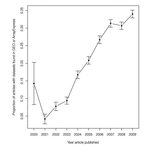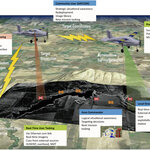Technology

A non-invasive disease detection facility has been unveiled for use in Leicester Royal Infirmary's A&E department. It will detect the "sight, smell and feel" of disease without the use of invasive probes, blood tests, or other time-consuming and uncomfortable procedures.
If you're thinking that sounds like Dr. McCoy's tricorder on the "Star Trek" television series, you are right. But right now it's more like his sick bay than a portable device.The University of Leicester have three different types of cutting-edge technology in combination under a range of situations. All…

To celebrate a half year of effort, this is a blog on weekly blogging. Three tangibles are created by the process: the Science20 blog, a YouTube videoblog, and a chapter in a book of blogs (still under development). I will go through my technical suite used in production. The 20-25 hours per week will be broken down. Some data on the level of interest will be shown. Finally, the rewards of this work will be reviewed.
The most important thing to maintaining production for a weekly blog, trumping all else, is having a topic to ramble about. There is a simple test: would talking about this…

A research project aims to improve the control of robot movements with the help of new mathematical approaches.
New developments in the areas of motion planning, computer-aided design and algebraic geometry aim to help in the identification of situations in which a collision may occur for a robot and the planning of an optimal motion path. Algebraic methods for the control of robot motions are being used for the first time in combination with numeric and geometric methods.
A robot is 'born', so to speak, with motor skills by way of program codes in its its microprocessor-based…

Webometrics faces many challenges, not the least of which is a dearth of tools capable of measuring the Web with any degree of accuracy. Most academic and professional Webometrics analysts alike have had to rely on a mix of search engine downloads and query operators. Yet even analysts from organizations with their own crawlers are challenged by the limitations of methodologies and technologies.
For several years one of the most popular tools used in measuring the Web has been the Yahoo! Site Explorer tool. However, Yahoo!'s business model has evolved through the years and…

A robot named MABEL was created in a University of Michigan lab but 'she' can run like a human, up to 6.8 miles per hour.
Unless HYDRA and SHIELD exist in secret underground lairs, MABEL is the world's fastest bipedal robot - with knees, that is.
MABEL was built in 2008 by Jessy Grizzle, a professor in the Department of Electrical Engineering and Computer Science at the University of Michigan, in collaboration with Jonathan Hurst, who was then a doctoral student at the Robotics Institute at Carnegie Mellon University and is now an assistant professor in the Department of Mechanical,…
At Science 2.0 we are not big fans of being clever just for the sake of being clever - we were smart kids and there are smart kids today and the belief by government funding agencies that STEM outreach needs to be cartoons and video games and mascots is a little patronizing to intelligent young people.
So young people do not need to be talked down to but some things are just cool and everyone likes cool - magic goggles and interactive maps are just that.
Gaetano Ling, an Imperial College London postgraduate, has developed interactive tools to make museums and galleries a little less 'dry' for…

National Geographic, which nows runs Scienceblogs.com, has put the hammer down on anonymous blogs.
Really, that whole thing was always a little sketchy. Supposedly the rationale was that these people were going to be edgy insiders revealing things too explosive for mainstream media and maybe damaging to their careers but it mostly ended up being a way to rant about politics without accountability.
Now, the drugmonkey column is actually pretty good - good enough that I read it and that's where I saw the announcement - but the paranoia has always run a little high over there.…

Five years into the Science 2.0 experiment I can tell you down to the eyeball how many people are involved in the communication pillar of it - but in the collaboration realm, it's not so easy.
Science 2.0 fave Heather A. Piwowar from the Department of Biomedical Informatics at Pitt recently gave it a shot, and the answer was...it's unknown.
In many aspects of science, sharing data is counter-productive to competition. If you publicize a failure, for example, you save a competitor a road you had to go down but if you share raw data of a success, it allows a competitor to quickly catch up…

In the modern world, even residents of London generate more intelligence, surveillance and reconnaissance (ISR) data than human operators can collate and that can severely limit the ability of an analyst to generate intelligence reports in operationally relevant time frames, like when ambassadors and looters are rioting and claiming it is for social justice.
Naval Research Laboratory may have the answer - a multi-user tracking capability which enables the system to manage collection of imagery without continuous monitoring by a ground or airborne operator, thus requiring fewer personnel and…

What is the shape of a Website? How does one determine "shape" from a collection of links and electronic files? Web designers, search engineers, and marketing consultants use geometric shapes like circles, rectangles, pyramids, and network diagrams to visually depict Website shapes but such illustrations fall short of representing the nature of Websites.
If you want to measure the World Wide Web you need to be able to measure a Website. It is not enough to merely count the number of registered domains, the number of domains actually serving content through HTTP or HTTPS…